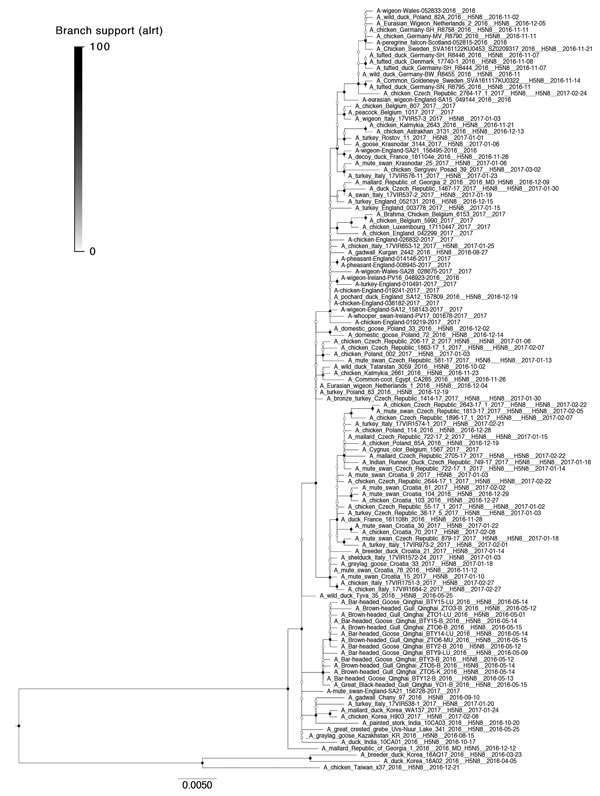Comparison of 2016–17 and Previous Epizootics of Highly Pathogenic Avian Influenza H5 Guangdong Lineage in Europe
Pablo Alarcon
1, Adam Brouwer
1
, Divya Venkatesh, Daisy Duncan, Chrysostomos I. Dovas, George Georgiades, Isabella Monne, Alice Fusaro, Adam Dan, Krzysztof Śmietanka, Vassilios Ragias, Andrew C. Breed, Taxiarchis Chassalevris, Gabriela Goujgoulova, Charlotte Kristiane Hjulsager, Eoin Ryan, Azucena Sánchez, Eric Niqueux, Niina Tammiranta, Siamak Zohari, David A. Stroud, Vladimir Savić, Nicola S. Lewis, and Ian H. Brown
Author affiliations: Royal Veterinary College, London, UK (P. Alarcon); Animal and Plant Health Agency, Addlestone, UK (P. Alarcon, A. Brouwer, D. Duncan, A.C. Breed, N.S. Lewis, I.H. Brown); University of Cambridge, Cambridge, UK (D. Venkatesh); Aristotle University of Thessaloniki, Thessaloniki, Greece (C.I. Dovas, T. Chassalevris); Ministry of Rural Development and Food, Thessaloniki (G. Georgiades, V. Ragias); Istituto Zooprofilattico Sperimentale delle Venezie, Padova, Italy (I. Monne, A. Fusaro); Veterinary Diagnostic Institute, Budapest, Hungary (A. Dan); National Veterinary Research Institute, Pulawy, Poland (K. Śmietanka); Department of Agriculture and Water Resources, Canberra, Australian Capital Territory, Australia (A.C. Breed); University of Queensland, Brisbane, Queensland, Australia (A.C. Breed); NDRVMI, Sofia, Bulgaria (G. Goujgoulova); Technical University of Denmark, Lyngby, Denmark (C.K. Hjulsager); Central Veterinary Research Laboratory, Celbridge, Ireland (E. Ryan); Central Veterinary Laboratory, Madrid, Spain (A. Sánchez); French Agency for Food, Environmental and Occupational Health & Safety, Ploufragan, France (E. Niqueux); Finnish Food Safety Authority Evira, Helsinki, Finland (N. Tammiranta); National Veterinary Institute and World Organisation for Animal Health Collaborating Center, Uppsala, Sweden (S. Zohari); Joint Nature Conservation Committee, Peterborough, UK (D.A. Stroud); Croatian Veterinary Institute, Zagreb, Croatia (V. Savić)
Main Article
Figure 6

Figure 6. Maximum-likelihood tree from viral sequences of the 2016–17 highly pathogenic avian influenza H5 epizootic in Europe. Circles represent node support values, filled according to approximate likelihood ratio test values 0–100. Light gray boxes indicate distinct clades with support >50 with isolates from Europe; dark gray boxes indicate clades with <50 or unresolved. Scale bar indicates nucleotide substitutions per site. An expanded figure showing trees for all 3 epizootic years is available online (https://wwwnc.cdc.gov/EID/article/24/12/17-1860-F6.htm).
Main Article
Page created: November 19, 2018
Page updated: November 19, 2018
Page reviewed: November 19, 2018
The conclusions, findings, and opinions expressed by authors contributing to this journal do not necessarily reflect the official position of the U.S. Department of Health and Human Services, the Public Health Service, the Centers for Disease Control and Prevention, or the authors' affiliated institutions. Use of trade names is for identification only and does not imply endorsement by any of the groups named above.
